Traditional Chinese Architecture 中国传统建筑
高考英语中国传统文化词汇

以下是一些高考英语中可能考察的中国传统文化词汇:
1. 春节(Spring Festival)
2. 丝绸之路(Silk Road)
3. 龙舟节(Dragon Boat Festival)
4. 中秋节(Mid-Autumn Festival)
5. 儒家思想(Confucianism)
6. 道家思想(Taoism)
7. 佛教(Buddhism)
8. 古琴(Guqin)
9. 京剧(Peking Opera)
10. 四大发明(Four Great Inventions of Ancient China)
11. 中国茶文化(Chinese tea culture)
12. 粤菜(Cantonese cuisine)
13. 传统汉服(Traditional Han Chinese clothing)
14. 中国古代建筑(Ancient Chinese architecture)
15. 书法(Calligraphy)
16. 饺子(Dumplings)
17. 高山流水(High Mountains and Flowing Waters)
18. 少林功夫(Shaolin Kung Fu)
19. 碟子(Chinese zither)
20. 京剧脸谱(Peking Opera facial makeup)
这些词汇涵盖了中国传统文化的不同方面,备考时可以通过阅读相关材料、观看相关纪录片或参加相关文化活动来进一步了解和复习。
中国十大国粹英语

中国十大国粹英语"国粹"是指一个国家的传统文化、艺术、文学等方面的瑰宝和代表作品。
中国的国粹丰富多彩,涵盖了各个领域。
以下是中国十大国粹的英语表达:1.京剧(Peking Opera):中国传统戏曲艺术的代表之一,以唱、念、做、打为主要表演形式。
2.书法(Chinese Calligraphy):以笔墨纸砚为工具,通过横、竖、撇、捺等笔画形成独特的艺术风格。
3.茶道(Chinese Tea Culture):中国传统的茶艺表演和茶文化,强调茶的品质、泡茶的技艺和品茶的情趣。
4.中国画(Traditional Chinese Painting):以水墨为主要材料,通过线条和色彩表现意境,强调审美和抒发情感。
5.中医(Traditional Chinese Medicine):包括针灸、中药等治疗方法,注重调理身体的整体平衡。
6.园林(Chinese Garden):以自然为基调,通过布局、建筑、植物等元素营造出具有中国文化特色的庭园。
7.传统建筑(Traditional Chinese Architecture):包括古代宫殿、寺庙、园林等建筑,注重与自然环境的和谐。
8.剪纸(Chinese Paper Cutting):通过剪刀在纸上创作出各种形状,是一种传统的手工艺术。
9.昆曲(Kunqu Opera):是中国古老的戏曲剧种之一,以其独特的音乐、表演和服饰风格而著称。
10.传统服饰(Traditional Chinese Clothing):如汉服、旗袍等,代表了中国古代的服饰文化。
这些都是中国传统文化的瑰宝,代表了中国千百年来的历史和文化积淀。
中国传统建筑的主要特点英语作文
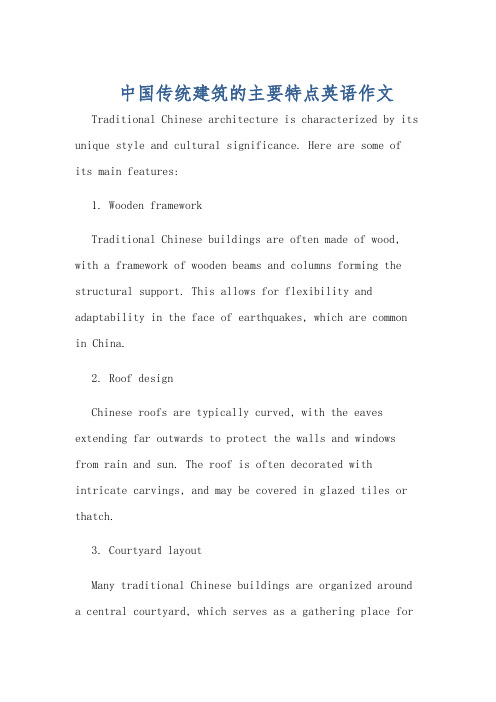
中国传统建筑的主要特点英语作文Traditional Chinese architecture is characterized by its unique style and cultural significance. Here are some ofits main features:1. Wooden frameworkTraditional Chinese buildings are often made of wood, with a framework of wooden beams and columns forming the structural support. This allows for flexibility and adaptability in the face of earthquakes, which are common in China.2. Roof designChinese roofs are typically curved, with the eaves extending far outwards to protect the walls and windows from rain and sun. The roof is often decorated with intricate carvings, and may be covered in glazed tiles or thatch.3. Courtyard layoutMany traditional Chinese buildings are organized around a central courtyard, which serves as a gathering place forfamily members and guests. The courtyard may be open to the sky or covered by a roof, and is often decorated with plants, rocks, and water features.4. Symmetry and balanceChinese architecture places great emphasis on symmetry and balance, with buildings often divided into equal halves or quarters. The use of feng shui principles also plays a role in the layout and design of traditional buildings.5. Decorative elementsTraditional Chinese buildings are often decorated with ornate carvings, paintings, and calligraphy. These may depict scenes from Chinese mythology, historical events, or everyday life.6. Integration with natureChinese architecture seeks to harmonize with the natural environment, incorporating elements such as gardens, ponds, and mountains into the design. The use of natural materials such as wood, stone, and bamboo also helps to create a sense of connection with the natural world.中国传统建筑以其独特的风格和文化意义而闻名。
高中英语 高考英语作文 有关中国传统文化的范文5篇

高中英语高考英语作文有关中国传统文化的范文5篇1. 主题:中国传统节日Chinese Traditional FestivalsChinese traditional festivals are an integral part of our culture and play a significant role in our lives. Among them, the Spring Festival, also known as Chinese New Year, is the most important one. It is a time for family reunions and celebration. People gather together, share delicious food, exchange gifts, and watch the lion and dragon dances. Another well-known festival is the Mid-Autumn Festival, during which families gather to appreciate the bright full moon and eat mooncakes, a traditional delicacy. These festivals not only bring joy and happiness but also promote the preservation of our cultural heritage.2. 主题:中国传统美食Traditional Chinese CuisineTraditional Chinese cuisine is renowned worldwide for its unique flavors and cooking techniques. One of the most famous dishes is Peking Roast Duck, which originated in Beijing and has a history of over 600 years. The crispy skin, tender meat, and fragrant aroma make it an irresistible delicacy. Another popular dish is Kung Pao Chicken, known for its perfect combination of spicy and savory flavors. Besides these, there are numerous regional specialties, such as Sichuan Hotpot, Cantonese Dim Sum, and Shanghai Soup Dumplings. These dishes not only satisfy our taste buds but also reflect the diversity and richness of Chinese culinary traditions.3. 主题:中国传统艺术Traditional Chinese ArtTraditional Chinese art has a long history and encompasses various forms, including calligraphy, painting, music, and opera. Chinese calligraphy is considered a unique art form and is highly regarded for its beauty and elegance. It requires precise brushwork and a deep understanding of Chinese characters. Chinese painting, known for its delicate brushstrokes and vibrant colors, often depicts landscapes, flowers, and birds. Traditional Chinese music, with its melodic tunes and distinctive instruments such as the guzheng and erhu, evokes emotions and reflects the spirit of our culture. Peking Opera, characterized by colorful costumes, elaborate makeup, and unique singing style, is a traditional form of Chinese theater. These art forms not only entertain but also serve as a medium to express our cultural values and aesthetics.4. 主题:中国传统服饰Traditional Chinese ClothingTraditional Chinese clothing, also known as hanfu, has a rich history and diversestyles. The traditional clothing for women often features flowing silk robes with vibrant colors and intricate embroidery. The qipao, a form-fitting dress with a high collar and slits on the sides, is another iconic traditional garment. For men, the traditional attire includes robes with wide sleeves and embroidered designs. The tangzhuang, a traditional Chinese suit, is a popular choice for formal occasions. These traditional garments not only reflect our cultural heritage but also showcase the elegance and grace of Chinese fashion.5. 主题:中国传统建筑Traditional Chinese ArchitectureTraditional Chinese architecture is characterized by its unique style, intricate designs, and harmonious integration with nature. The Forbidden City in Beijing, with its grand palaces and magnificent gates, is a prime example of traditional Chinese architecture. The Temple of Heaven, a masterpiece of ancient Chinese architecture, features exquisite wooden structures and beautiful gardens. The Great Wall, a world-famous architectural wonder, showcases the remarkable engineering skills of ancient Chinese people. These architectural marvels not only demonstrate our ancestors' wisdom and craftsmanship but also serve as cultural symbols and tourist attractions.。
中国传统建筑 作文英文

中国传统建筑作文英文English:Chinese traditional architecture, characterized by exquisite craftsmanship, intricate wooden structures, and harmonious integration with nature, reflects the unique cultural identity and philosophical beliefs of the Chinese people. From ancient palaces like the Forbidden City to traditional courtyard houses, each building is carefully designed to adhere to the principles of feng shui and yin-yang balance. The use of natural materials like wood, stone, and ceramic tiles not only enhances the aesthetic appeal but also demonstrates a deep respect for the environment. Additionally, traditional Chinese architecture often features curved eaves, decorative motifs like dragons and phoenixes, and intricate lattice windows, all of which symbolize wealth, prosperity, and protection. Moreover, the layout of traditional Chinese buildings follows a symmetrical and hierarchical structure, with the emphasis on creating a harmonious flow of energy known as qi. Overall, Chinese traditional architecture embodies a rich heritage of architectural wisdom and cultural symbolism that continues to inspire generations of architects and designers worldwide.Translated content:中国传统建筑以精湛的工艺、错综复杂的木质结构和与自然的和谐融合为特征,体现了中国人民独特的文化认同和哲学信仰。
高考英语作文范文5篇 中国传统文化
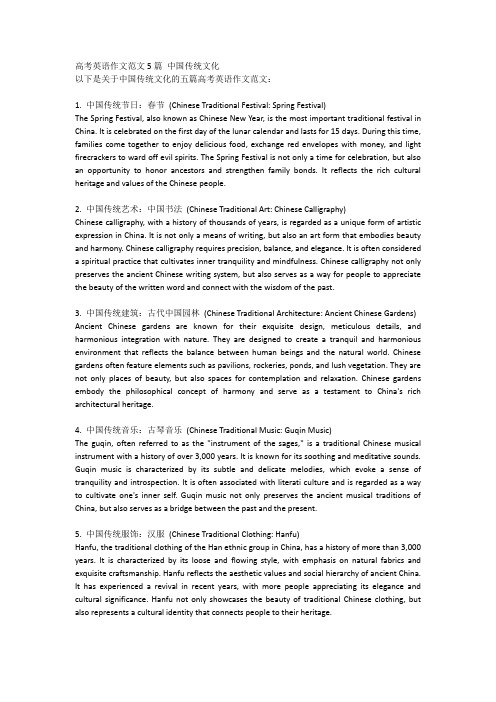
高考英语作文范文5篇中国传统文化以下是关于中国传统文化的五篇高考英语作文范文:1. 中国传统节日:春节(Chinese Traditional Festival: Spring Festival)The Spring Festival, also known as Chinese New Year, is the most important traditional festival in China. It is celebrated on the first day of the lunar calendar and lasts for 15 days. During this time, families come together to enjoy delicious food, exchange red envelopes with money, and light firecrackers to ward off evil spirits. The Spring Festival is not only a time for celebration, but also an opportunity to honor ancestors and strengthen family bonds. It reflects the rich cultural heritage and values of the Chinese people.2. 中国传统艺术:中国书法(Chinese Traditional Art: Chinese Calligraphy)Chinese calligraphy, with a history of thousands of years, is regarded as a unique form of artistic expression in China. It is not only a means of writing, but also an art form that embodies beauty and harmony. Chinese calligraphy requires precision, balance, and elegance. It is often considered a spiritual practice that cultivates inner tranquility and mindfulness. Chinese calligraphy not only preserves the ancient Chinese writing system, but also serves as a way for people to appreciate the beauty of the written word and connect with the wisdom of the past.3. 中国传统建筑:古代中国园林(Chinese Traditional Architecture: Ancient Chinese Gardens) Ancient Chinese gardens are known for their exquisite design, meticulous details, and harmonious integration with nature. They are designed to create a tranquil and harmonious environment that reflects the balance between human beings and the natural world. Chinese gardens often feature elements such as pavilions, rockeries, ponds, and lush vegetation. They are not only places of beauty, but also spaces for contemplation and relaxation. Chinese gardens embody the philosophical concept of harmony and serve as a testament to China's rich architectural heritage.4. 中国传统音乐:古琴音乐(Chinese Traditional Music: Guqin Music)The guqin, often referred to as the "instrument of the sages," is a traditional Chinese musical instrument with a history of over 3,000 years. It is known for its soothing and meditative sounds. Guqin music is characterized by its subtle and delicate melodies, which evoke a sense of tranquility and introspection. It is often associated with literati culture and is regarded as a way to cultivate one's inner self. Guqin music not only preserves the ancient musical traditions of China, but also serves as a bridge between the past and the present.5. 中国传统服饰:汉服(Chinese Traditional Clothing: Hanfu)Hanfu, the traditional clothing of the Han ethnic group in China, has a history of more than 3,000 years. It is characterized by its loose and flowing style, with emphasis on natural fabrics and exquisite craftsmanship. Hanfu reflects the aesthetic values and social hierarchy of ancient China. It has experienced a revival in recent years, with more people appreciating its elegance and cultural significance. Hanfu not only showcases the beauty of traditional Chinese clothing, but also represents a cultural identity that connects people to their heritage.以上是关于中国传统文化的五篇高考英语作文范文,希望对你有所帮助。
高中高考英语作文范文5篇 中国传统文化

高中高考英语作文范文5篇中国传统文化以下是五篇关于中国传统文化的高中高考英语作文范文:1. 中国传统节日- 春节(Chinese Traditional Festival - Spring Festival)The Spring Festival, also known as Chinese New Year, is the most important traditional festival in China. It is celebrated on the first day of the lunar calendar and lasts for 15 days. During this time, people engage in various activities to welcome the new year and pray for good fortune.Firstly, people thoroughly clean their houses to remove any bad luck from the previous year. Then, they decorate their homes with red lanterns and paper cuttings, which symbolize happiness and good luck. Family members gather for a reunion dinner, enjoying delicious traditional food and exchanging gifts.Fireworks and firecrackers are set off to scare away evil spirits. The streets are filled with lion and dragon dances, as well as traditional performances like the Beijing Opera. Red envelopes containing money are given to children and unmarried adults as a symbol of good luck.The Spring Festival is not only a time for celebration but also an opportunity to honor ancestors and show respect to elders. It highlights the importance of family unity and traditional values in Chinese culture.2. 中国传统艺术- 京剧(Chinese Traditional Art - Peking Opera)Peking Opera, also known as Beijing Opera, is a traditional form of Chinese theater that combines music, singing, dialogue, and acrobatics. It originated in the late 18th century and has since become one of China's most iconic art forms.Peking Opera is characterized by its elaborate costumes, colorful makeup, and unique vocal techniques. Performers use exaggerated gestures and movements to convey emotions and tell stories. The repertoire includes historical dramas, mythological tales, and literary adaptations.The art of Peking Opera requires years of dedicated training. Performers learn to sing in a distinct style and master various skills, such as martial arts and acrobatics. The music is accompanied by traditional instruments like the erhu and the pipa, creating a harmonious blend of sound and visuals.Peking Opera is not only a form of entertainment but also an important cultural heritage. It reflects the rich history and values of Chinese society, promoting traditional virtues such as loyalty, bravery, and filial piety. It continues to captivate audiences both in China and around the world.3. 中国传统建筑- 故宫(Chinese Traditional Architecture - The Forbidden City)The Forbidden City, also known as the Palace Museum, is a magnificent architectural masterpiece located in the heart of Beijing. It served as the imperial palace during the Ming and Qing dynasties, housing emperors and their households for nearly 500 years.The Forbidden City is a symbol of China's rich cultural heritage and architectural prowess. It covers a vast area with over 9,000 rooms, featuring exquisite designs and intricate details. The complex is surrounded by high walls and a moat, emphasizing its grandeur and providing a sense of security.The architecture of the Forbidden City follows traditional Chinese principles of balance and harmony. The buildings are arranged symmetrically along a central axis, with the Hall of Supreme Harmony as the main ceremonial hall. The roofs are adorned with colorful glazed tiles, representing the imperial status.Visiting the Forbidden City is like stepping back in time and experiencing the grandeur of ancient China. It offers a glimpse into the lives of emperors and their courts, as well as the cultural and artistic achievements of the time. It is a UNESCO World Heritage Site and a testament to China's architectural brilliance.4. 中国传统饮食- 中餐(Chinese Traditional Cuisine)Chinese cuisine, also known as Chinese food, is one of the most diverse and popular cuisines in the world. It is characterized by its rich flavors, varied cooking techniques, and emphasis on fresh ingredients.Chinese cuisine can be divided into eight major regional cuisines, each with its own distinctive style and flavors. Some famous examples include Sichuan cuisine, known for its bold and spicy flavors, and Cantonese cuisine, renowned for its delicate and fresh ingredients.Traditional Chinese dishes often feature a combination of meat, vegetables, and grains. They are cooked using various methods, such as stir-frying, steaming, and braising. Popular ingredients include rice, noodles, soy sauce, garlic, and ginger.In addition to its delicious taste, Chinese cuisine also embodies cultural values and customs. It promotes the concept of balance and harmony, as seen in the use of Yin and Yang principles in food preparation. The tradition of sharing meals with family and friends reinforces the importance of togetherness and hospitality.5. 中国传统医学- 中医(Chinese Traditional Medicine)Traditional Chinese Medicine (TCM) is a holistic approach to healthcare that has been practiced for thousands of years. It encompasses various therapies, including herbal medicine, acupuncture, massage, and dietary therapy.TCM is based on the concept of Qi (vital energy) and the balance of Yin and Yang. It views the body as an interconnected system, where imbalances or blockages can lead to illness. TCM aims to restore harmony and promote overall well-being.Herbal medicine is a fundamental component of TCM. It involves the use of natural substances, such as plants, roots, and minerals, to treat ailments and strengthen the body. Acupuncture, on the other hand, involves the insertion of thin needles into specific points on the body to stimulate energy flow.TCM has gained recognition worldwide for its effectiveness and holistic approach to health. It not only focuses on treating symptoms but also addresses the root causes of diseases. TCM offers a natural and balanced way of maintaining health and preventing illness.以上是五篇关于中国传统文化的高中高考英语作文范文,希望对你有所帮助。
英语四级中国传统文化的单词
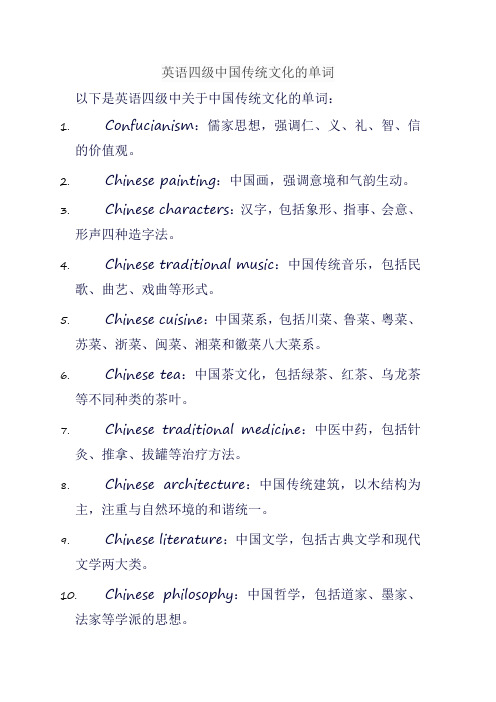
英语四级中国传统文化的单词
以下是英语四级中关于中国传统文化的单词:
1.Confucianism:儒家思想,强调仁、义、礼、智、信
的价值观。
2.Chinese painting:中国画,强调意境和气韵生动。
3.Chinese characters:汉字,包括象形、指事、会意、
形声四种造字法。
4.Chinese traditional music:中国传统音乐,包括民
歌、曲艺、戏曲等形式。
5.Chinese cuisine:中国菜系,包括川菜、鲁菜、粤菜、
苏菜、浙菜、闽菜、湘菜和徽菜八大菜系。
6.Chinese tea:中国茶文化,包括绿茶、红茶、乌龙茶
等不同种类的茶叶。
7.Chinese traditional medicine:中医中药,包括针
灸、推拿、拔罐等治疗方法。
8.Chinese architecture:中国传统建筑,以木结构为
主,注重与自然环境的和谐统一。
9.Chinese literature:中国文学,包括古典文学和现代
文学两大类。
10.Chinese philosophy:中国哲学,包括道家、墨家、
法家等学派的思想。
这些单词可以用于描述中国传统文化的内容和特点,帮助您更好地了解和掌握相关的英语表达方式。
中国传统建筑介绍英语作文
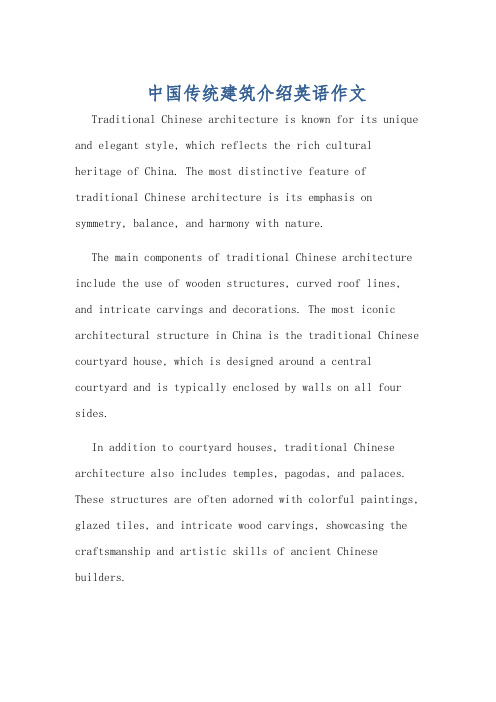
中国传统建筑介绍英语作文Traditional Chinese architecture is known for its unique and elegant style, which reflects the rich cultural heritage of China. The most distinctive feature of traditional Chinese architecture is its emphasis on symmetry, balance, and harmony with nature.The main components of traditional Chinese architecture include the use of wooden structures, curved roof lines, and intricate carvings and decorations. The most iconic architectural structure in China is the traditional Chinese courtyard house, which is designed around a central courtyard and is typically enclosed by walls on all four sides.In addition to courtyard houses, traditional Chinese architecture also includes temples, pagodas, and palaces. These structures are often adorned with colorful paintings, glazed tiles, and intricate wood carvings, showcasing the craftsmanship and artistic skills of ancient Chinese builders.The use of feng shui principles is also an important aspect of traditional Chinese architecture, as buildingsare often positioned and designed to harmonize with the surrounding environment and promote positive energy flow.Overall, traditional Chinese architecture is a testament to the ingenuity and creativity of ancient Chinese builders, and it continues to inspire and influence modern architectural designs.中国传统建筑以其独特和优雅的风格而闻名,反映了中国丰富的文化遗产。
中国文化之-建筑(中英文)

the use of cloud computing technology to collect and analyze data from various building systems, providing
decision support for building management.
Water conservation
the use of water-saving technologies and devices to reduce water consumption in buildings, such as low-flow faucets and water-saving toilets.
Respect for human needs
the design of buildings should respect human needs and preferences, providing comfortable and convenient living spaces.
Inቤተ መጻሕፍቲ ባይዱegration of traditional culture
Promotion of intelligent buildings
Smart sensors
the application of smart sensors in buildings to monitor and control building systems, such as lighting, air conditioning and security.
雕刻是中国传统建筑中最为常见的装饰形式之一,包括木 雕、石雕、砖雕等。雕刻的题材广泛,包括花卉、动物、 人物等,通过雕刻可以表现出极高的艺术价值和深厚的文 化底蕴。
中国传统建筑介绍英语作文
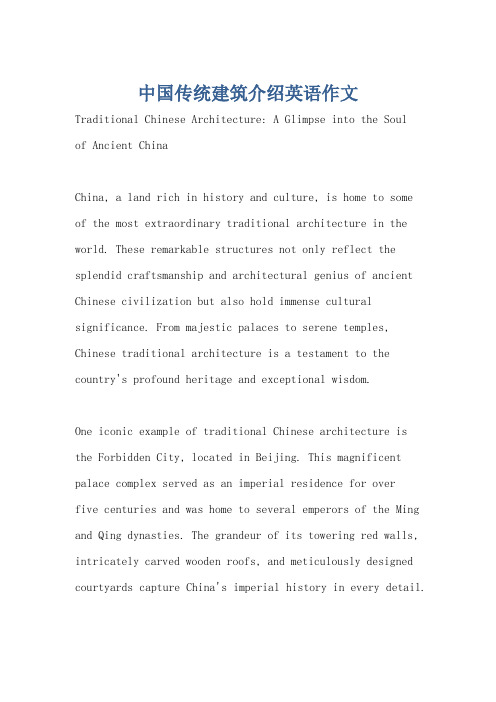
中国传统建筑介绍英语作文Traditional Chinese Architecture: A Glimpse into the Soulof Ancient ChinaChina, a land rich in history and culture, is home to someof the most extraordinary traditional architecture in the world. These remarkable structures not only reflect the splendid craftsmanship and architectural genius of ancient Chinese civilization but also hold immense cultural significance. From majestic palaces to serene temples, Chinese traditional architecture is a testament to the country's profound heritage and exceptional wisdom.One iconic example of traditional Chinese architecture isthe Forbidden City, located in Beijing. This magnificent palace complex served as an imperial residence for overfive centuries and was home to several emperors of the Ming and Qing dynasties. The grandeur of its towering red walls, intricately carved wooden roofs, and meticulously designed courtyards capture China's imperial history in every detail.Another must-see architectural masterpiece is the Great Wall of China. Snaking across mountains and valleys for thousands of kilometers, this colossal structure stands as a symbol of strength, determination, and resilience. Built to protect China from invaders during various dynasties, each brick used in constructing this engineering marvel carries a weighty historical legacy.In addition to grand palaces and formidable walls, traditional Chinese architecture also encompasses elegant Buddhist temples that blend harmony with nature. For instance, the White Horse Temple in Luoyang stands as one of China's oldest Buddhist temples. Its exquisite design features intricate stone carvings depicting stories from Buddhism's vast scriptures. The temple's peaceful atmosphere transports visitors into a realm where ancient wisdom meets tranquility.The Yingxian Wooden Pagoda is another remarkable example that showcases the sophistication of traditional Chinese architecture. Located in Shanxi Province, this pagoda dates back over 900 years and boasts its original woodenstructure without any nails or cement holding it together. Its intricate yet stable design is a testament to the brilliance of ancient Chinese carpentry techniques.Chinese gardens are yet another striking aspect of traditional Chinese architecture. The classical gardens in Suzhou, such as the Humble Administrator's Garden and Lingering Garden, exemplify the concept of harmonious coexistence between humans and nature. These artfully designed landscapes feature meandering paths, elegant pavilions, serene ponds, and carefully selected vegetation, creating a tranquil oasis that invites contemplation and tranquility.What truly sets Chinese traditional architecture apart is its deep-rooted symbolism. Every architectural element carries hidden meanings that embody philosophical concepts like feng shui and yin-yang harmony. For instance, the curvature of a roof represents an upwardly rising dragon bringing fortune and protection to the building.In conclusion, exploring traditional Chinese architectureoffers a tangible connection to ancient China's rich heritage. From the awe-inspiring Forbidden City and Great Wall to the serene Buddhist temples and harmonious gardens, these architectural wonders reflect the depths of wisdom and cultural traditions inherent in Chinese history. Through their intricate designs, unique construction methods, and profound symbolism, traditional Chinese buildings provide a lasting testament to the sophistication of ancient Chinese civilization. So next time you encounter one of these magnificent structures, remember it is not merely a physical edifice but also a gateway into the soul of ancient China itself.。
高中英语 高考英语作文有关中国传统文化的范文5篇带中文翻译

高中英语高考英语作文有关中国传统文化的范文5篇带中文翻译范文1:传统建筑Traditional Chinese architecture has a long history and outstanding artistic value. It reflects the cultural inheritance and spiritual characteristics of the Chinese nation, and is also an important component of the treasure trove of Chinese art.The characteristics of traditional architecture are emphasizing harmony, respecting nature, emphasizing meteorology, and reflecting national culture. Typical traditional buildings include various bridges on the Beijing Hangzhou Grand Canal, temples, gardens and different kinds of folk houses with different styles on both sides of the river. For example, the roof tiles, eaves, arch of wooden architecture and sculptures of ancient buildings have superb skills and exquisite aesthetic values. In traditional architecture, it also reflects the development of politics, economy, and culture. Nowadays, traditional architecture has not only become an important part of China's cultural soft power, but also an important role in Sino foreign exchanges, Chinese cities, and the tourism market. The value and significance of traditional architecture are receiving increasing attention and recognition.中国传统建筑,有着悠久的历史和卓越的艺术价值。
中国传统建筑的特点及代表性建筑的英语作文
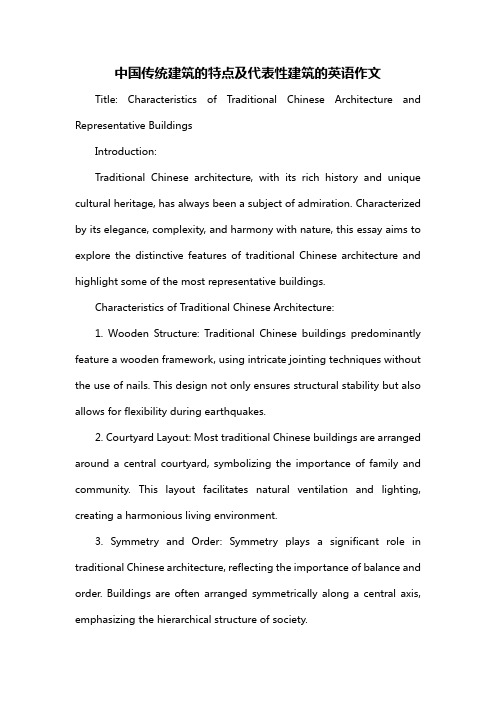
中国传统建筑的特点及代表性建筑的英语作文Title: Characteristics of Traditional Chinese Architecture and Representative BuildingsIntroduction:Traditional Chinese architecture, with its rich history and unique cultural heritage, has always been a subject of admiration. Characterized by its elegance, complexity, and harmony with nature, this essay aims to explore the distinctive features of traditional Chinese architecture and highlight some of the most representative buildings.Characteristics of Traditional Chinese Architecture:1. Wooden Structure: Traditional Chinese buildings predominantly feature a wooden framework, using intricate jointing techniques without the use of nails. This design not only ensures structural stability but also allows for flexibility during earthquakes.2. Courtyard Layout: Most traditional Chinese buildings are arranged around a central courtyard, symbolizing the importance of family and community. This layout facilitates natural ventilation and lighting, creating a harmonious living environment.3. Symmetry and Order: Symmetry plays a significant role in traditional Chinese architecture, reflecting the importance of balance and order. Buildings are often arranged symmetrically along a central axis, emphasizing the hierarchical structure of society.4. Decorative Elements: Traditional Chinese architecture is renowned for its elaborate decorations, including carved beams, painted rafters, and intricate roof tiles. These elements not only enhance the aesthetic appeal but also carry symbolic meanings.5. Roof Design: Chinese buildings feature distinctive roof designs, such as the hip-and-gable roof, the flat roof, and the pavilion roof. These designs often incorporate upturned eaves, symbolizing the heavens, and are adorned with mythical creatures to ward off evil spirits.Representative Buildings:1. The Forbidden City (Beijing): As the largest and best-preserved ancient imperial palace complex in the world, the Forbidden City showcases the epitome of traditional Chinese architecture. Its grandeur, intricate decorations, and symmetrical layout are testament to the architectural prowess of ancient China.2. The Temple of Heaven (Beijing): Built in the 15th century, the Temple of Heaven is an architectural masterpiece symbolizing the relationship between the human world and the divine. Its circular shape, representing heaven, and the surrounding square walls, symbolizing earth, embody the ancient Chinese concept of harmony between humans and nature.3. The Potala Palace (Lhasa, Tibet): Once the winter palace of the Dalai Lamas, the Potala Palace is a remarkable fusion of Tibetan and Chinesearchitectural styles. Its towering structure, white walls, and golden roofs create a striking silhouette against the高原landscape.4. The Longsheng Rice Terraces (Guangxi): While not a building in the traditional sense, the Longsheng Rice T erraces are a testament to the harmonious coexistence between humans and nature. These terraced fields, carved into the mountains, demonstrate the ingenuity of ancient Chinese agricultural practices and the integration of architecture with the landscape.Conclusion:Traditional Chinese architecture, with its unique characteristics and representative buildings, stands as a testament to the rich cultural heritage of China. Its emphasis on harmony with nature, intricate decorations, and symmetrical layouts continue to inspire and captivate people around the world.。
中国传统建筑特点英语作文

中国传统建筑特点英语作文English: Traditional Chinese architecture is characterized by its unique style, intricate wooden structures, and emphasis on harmony with nature. Traditional Chinese buildings often feature curved roofs, upturned eaves, and intricate carvings that symbolize prosperity and good fortune. The use of wooden materials and traditional craftsmanship techniques such as mortise and tenon joints highlight the high level of skill and precision required in constructing these buildings. Additionally, traditional Chinese architecture places a strong emphasis on feng shui principles, with buildings situated to promote positive energy flow and balance. Overall, traditional Chinese architecture embodies a deep connection to cultural beliefs and philosophies, reflecting the rich history and aesthetics of Chinese civilization.中文翻译: 中国传统建筑以其独特风格、精美的木结构和强调与自然和谐的特点而闻名。
介绍中国传统建筑的英语作文

介绍中国传统建筑的英语作文English:Traditional Chinese architecture is characterized by its unique style, elaborate wooden structures, and emphasis on harmony with nature. The most iconic feature of traditional Chinese architecture is the curved and sloping roofs, which are often adorned with intricate carvings and colorful tiles. The wooden columns and beams are also meticulously crafted to create a sense of grace and beauty. Traditional Chinese buildings are typically designed around a central courtyard, with rooms arranged in a symmetrical layout. This layout not only maximizes natural light and ventilation but also promotes a sense of balance and harmony. Additionally, traditional Chinese architecture often incorporates elements of feng shui to create a harmonious and auspicious living environment. Overall, traditional Chinese architecture reflects the cultural values of balance, harmony, and beauty.中文翻译:传统的中国建筑以其独特的风格、精美的木制结构和强调与自然和谐的特点而闻名。
中国传统建筑的特点及代表性建筑的英语作文

中国传统建筑的特点及代表性建筑的英语作文English:Chinese traditional architecture is characterized by its emphasis on harmony with nature, symmetry, and grandeur. The use of wooden structures, intricate carvings, and curved roof lines are common features in traditional Chinese buildings. One of the most iconic examples of traditional Chinese architecture is the Forbidden City in Beijing, which was the imperial palace during the Ming and Qing dynasties. The complex is comprised of numerous halls, pavilions, and courtyards, showcasing the intricate craftsmanship and detailed designs that are synonymous with Chinese architecture. Another famous example is the Temple of Heaven, also located in Beijing, which was used by emperors to pray for good harvests and peace in ancient times. The temple's circular design and its precise layout symbolize the connection between heaven and earth in Chinese cosmology. Overall, Chinese traditional architecture reflects the country's rich cultural heritage and architectural achievements throughout history.中文翻译:中国传统建筑以与自然的和谐、对称和宏伟为特点。
关于中国传统建筑的英语手抄报

关于中国传统建筑的英语手抄报《Chinese Traditional Architecture》Introduction:Chinese traditional architecture is a significant aspect of the country's rich cultural heritage. It reflects the profound philosophy, profound history, and delicate artistry of ancient China. Chinese traditional architecture not only showcases exquisite craftsmanship but also embodies the harmony between man and nature. This article will explore the key features, styles, and cultural significance of Chinese traditional architecture.Key Features of Chinese Traditional Architecture:1. Emphasis on balance and harmony: Chinese traditional architecture places great importance on achieving a balanced and harmonious design. The layout and arrangement of buildings, courtyards, and gardens are meticulously planned to create a sense of symmetry and balance.2. Integration with the environment: Unlike modern architecture, which often dominates the landscape, traditional Chinese architecture seeks to harmonize with its surroundings. It respects and integrates the natural environment, incorporating elements such as hills, rivers, and trees into the overall design.3. Use of traditional building materials: Traditional building materials such as wood, stone, and clay are extensively used in Chinese architecture. These materials not only provide durability but also offer a sense of warmth and natural beauty.Styles of Chinese Traditional Architecture:1. Imperial palace architecture: The Forbidden City in Beijing is a prime example of imperial palace architecture in China. It embodies the grandeur and magnificence of the ancient Chinese emperors. With its symmetrical layout, exquisite decorations, and classically elegant structures, it represents the pinnacle of Chinese architectural art.2. Garden architecture: Chinese gardens are known for their exquisite designs, poetic landscapes, and delicate pavilions. Suzhou Gardens, a UNESCO World Heritage Site, showcases the perfect combination of nature and architectural art. The gardens feature serene ponds, artfully landscaped rocks, and meticulously designed pavilions, exemplifying the Chinese belief in the harmony between man and nature.3. Traditional residential architecture: Traditional Chinese houses, represented by the courtyard houses (Siheyuan), reflect the lifestyle and social customs of ancient Chinese society. With their courtyard-centered layout, wooden structures, and decorative elements like moon gates and painted beams, these residences encapsulate the essence of Chinese culture and family values.Cultural Significance of Chinese Traditional Architecture:1. Reflection of Chinese philosophy: Chinese traditional architecture embodies philosophical concepts such as balance, harmony, and the integration of man and nature. It reflects the belief in the interconnectedness of all things and the pursuit of harmony between humans and their surroundings.2. Preservation of cultural heritage: Chinese traditional architecture represents the accumulated wisdom and artistic achievements of multiple dynasties. It serves as a testament to the historical and cultural identity of the Chinese people and plays a crucial role in preserving their heritage and national pride.3. Influence on other architectural styles: Chinese traditional architecture has influenced many architectural styles in neighboring countries such as Japan and Korea. Its architectural principles, design techniques, and ornamental patterns have left a lasting impact on these cultures, creating a sense of shared heritage within the East Asian region.Conclusion:Chinese traditional architecture stands as a testament to the creativity and ingenuity of ancient Chinese civilization. With its emphasis on balance, harmony, and integration with nature, it continues to inspire and captivate people worldwide. By appreciating and preserving this architectural heritage, we can gain a deeper understanding of Chinese culture and contribute to the preservation of our shared human heritage.。
介绍中国传统建筑的英语作文
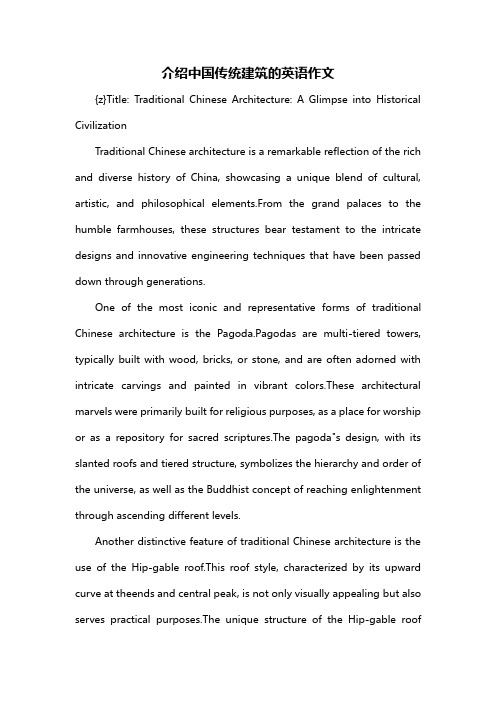
介绍中国传统建筑的英语作文{z}Title: Traditional Chinese Architecture: A Glimpse into Historical CivilizationTraditional Chinese architecture is a remarkable reflection of the rich and diverse history of China, showcasing a unique blend of cultural, artistic, and philosophical elements.From the grand palaces to the humble farmhouses, these structures bear testament to the intricate designs and innovative engineering techniques that have been passed down through generations.One of the most iconic and representative forms of traditional Chinese architecture is the Pagoda.Pagodas are multi-tiered towers, typically built with wood, bricks, or stone, and are often adorned with intricate carvings and painted in vibrant colors.These architectural marvels were primarily built for religious purposes, as a place for worship or as a repository for sacred scriptures.The pagoda"s design, with its slanted roofs and tiered structure, symbolizes the hierarchy and order of the universe, as well as the Buddhist concept of reaching enlightenment through ascending different levels.Another distinctive feature of traditional Chinese architecture is the use of the Hip-gable roof.This roof style, characterized by its upward curve at theends and central peak, is not only visually appealing but also serves practical purposes.The unique structure of the Hip-gable roofallows for better drainage of rainwater and provides increased stability to the building.Additionally, the roof is often adorned with intricate decorations such as ceramic tiles, wooden carvings, and even mythical creatures, symbolizing good fortune and protection.The Forbidden City, located in the heart of Beijing, is perhaps the most famous example of traditional Chinese architecture.It is a vast complex of palaces, temples, and gardens, built over a span of 400 years.The city"s design follows the traditional Chinese philosophy of balance and harmony, with its north-south axis symbolizing the cosmic order.The use of yellow, the imperial color, is prominent in the Forbidden City, signifying power, wealth, and status.Traditional Chinese architecture is also characterized by its use of intricate woodwork and joinery techniques.wooden structures are often connected without the use of nails, relying on precise cuts and interlocking components to hold the building together.This not only showcases the high level of craftsmanship but also allows for greater flexibility and resilience in the structure.In conclusion, traditional Chinese architecture is a testament to the ingenuity and artistic prowess of ancient Chinese civilization.With its unique designs, symbolic meanings, and innovative engineering techniques, it continues to inspire and captivate people around the world.。
- 1、下载文档前请自行甄别文档内容的完整性,平台不提供额外的编辑、内容补充、找答案等附加服务。
- 2、"仅部分预览"的文档,不可在线预览部分如存在完整性等问题,可反馈申请退款(可完整预览的文档不适用该条件!)。
- 3、如文档侵犯您的权益,请联系客服反馈,我们会尽快为您处理(人工客服工作时间:9:00-18:30)。
Residential Houses(民居建筑)
Residential houses refer to the house of the common people in different parts of China.
— used in ancient times for the storage of important articles and documents — a place where educated men used to gather to write articles and hold banquets — used for enjoying the sights
Tombs and Mausoleums(陵墓建筑)
People of all social classes had their tombs carefully built. Over the centuries, the craft of tomb construction gradually merged with arts like painting, calligraphy and sculpture. It eventually became its own art form.
the Wei-Yang Palace
Han Dynasty
Wei and Jin Period and Southern and Northern Dynasties
remarkable grottoes(石窟), Buddhist pagodas and imperial mausoleums (帝王陵墓)
Terraces
As an ancient architectural structure of Chinese, the tai was a very much elevated terrace with a flat top, generally built of earth and stone and surfaced with brick.
g
The Imperial Summer Villa of Chengde
The Summer Palace
Private Gardens
The Humble Administrator's Garden (拙政园) Lingering Garden(留园)
Lion Grove Garden(狮子林)
Traditional Chinese Gardens(园林建筑)
The most distinguishing feature of traditional Chinese gardens is their natural mountain-and-water style. Chinese garden architecture includes both grand imperial gardens and delicate private ones. Imperial Gardens
Traditional Chinese Architecture
王媛 3113356004
Contents
1. A Brief Introduction to Traditional Chinese Architecture 2. Different Types of Traditional Chinese Architecture 3. Features and Cultural Connotations of Traditional Chinese Architecture
Sui and Tang Dynasty Buddhism and Taoism palaces and temples were constructed actively
. .
Five-Kingdoms-Song-Liao-Jin Period
stressed constructing palaces,but have been nearly destroyed
Functions of terraces :
— as an observatory (观象台) — as beacon towers(烽火台) along the Great Wall — in honor of the sincere friendship
multi-story buildings A lou can refer to any building oftwo or more storeys with a horizontal main ridge.
many pagodas and stone steles(石碑) were constructed with high standard and fine workmanship the Yuan,Ming and Qing Dynasties . imperial palaces and the constructions amazed the world
Canglang Pavilion (沧浪亭)
Altars and Temples (坛庙建筑)
Altars and temples built in ancient China were meant for practice of rites. Three categories: —imperial temples and altars for worshiping of Heaven, the earth, the sun, the moon and the imperial ancestors — commemorative temples for dead people of great virtue — family temples TheTemple of Heaven Shaolin Temple
Religious Structures(宗教建筑)
Taoist Temple Constructions A Chinese Taoist temple, generally called gong(宫) or guan(观) in Chinese, is the holy hall where Taoists perform their religious ceremonies. The Qingcheng Mountain The White Cloud Taoist Temple
the Great Wall
the Dujiangyan Water-Conservancy Project
E Pang Palace
the Emperor Qin Shihuang's Mausoleum
the Greatater-Conservancy Project
Functions of multi-story buildings : — for military use — as private homes — as belvederes(望景楼) — as bell and drum towers
storyed pavilions (usu. two) Functions of storyed pavilions :
Architectural Features of imperial palaces:
--The ancient palaces were strictly laid out on central axis. -- Yellow roof tiles were used. --The wooden columns of the buildings, as well as the surface of the walls, tend to be red in color. --The Chinese dragon was heavily used on Imperial architecture.
Nowadays . traditional architectural activities have sloewd down and more western factors have begun to show up
2. Different Types of Traditional Chinese Architecture
Five major styles of residential huoses in China:
Classification by structure: Chinese pavilions Chinese Pavilions are covered structures without surrounding walls. Types of Chinese Pavilion:
Round, square, triangular, hexagonal(六角亭), octagonal(八角亭)pavilions, etc.
Functions of Chinese Pavilion:
Practical function:
•— used for military and governmental purposes •— as a place for rest •— as a roof to a stone tablet
Buddhist Temple Constructions Buddhist Temple Constructions in China include Buddhist temples, monasteries, pagodas, Buddhist halls and grottoes, which are called si (佛寺), ta (佛塔), dian (佛殿)and shiku (石窟) in Chinese respectively.
